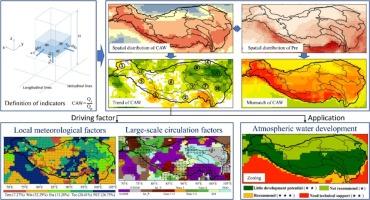Analysis of the evolutionary patterns and drivers of Capturability of Atmospheric Water (CAW) on the Qinghai-Tibet Plateau
IF 4.4
2区 地球科学
Q1 METEOROLOGY & ATMOSPHERIC SCIENCES
引用次数: 0
Abstract
The Qinghai-Tibet Plateau (QTP) is a climate-sensitive region with profound implications for the atmospheric water cycle in both Asia and the globe. While global warming has increased precipitation and atmospheric water-holding capacity, energy constraints prevent a proportional relationship between atmospheric water content and global mean precipitation changes. In this study, we utilized multi-source precipitation datasets (ERA5-Land, CPC, CRU, CMAP, GPCP) and atmospheric water flux data (ERA5) to investigate the conversion of atmospheric water to precipitation, a fundamental water cycle process, across the QTP and its surrounding regions from 1979 to 2020 using the Capturability of Atmospheric Water (CAW) index. Our findings reveal a dipole evolution pattern in CAW, with strengthening in the north and weakening in the south. The QTP, a positive mismatch region with limited atmospheric water but efficient precipitation conversion, is highly sensitive to climate change. The evolution of CAW is driven by meteorological factors, with cloud cover and actual evapotranspiration enhancing CAW in the northeastern QTP, while potential evapotranspiration weakens CAW in the southeastern QTP. On a larger scale, CAW evolution is modulated by large-scale atmospheric circulation patterns, where the East Asian summer monsoon enhances CAW in the northeast, while the South Asian summer monsoon weakens CAW in the southeast. Additionally, a qualitative assessment of atmospheric water resource potential, integrating CAW and water vapor transport flux, identifies four distinct development models. These findings provide critical insights for water resource management and climate adaptation strategies in the QTP.

虽然全球变暖增加了降水和大气持水能力,但能量限制阻碍了大气含水量与全球平均降水变化之间的比例关系。利用多源降水数据集(ERA5- land、CPC、CRU、CMAP、GPCP)和大气水通量数据(ERA5),利用大气水可捕获性指数(CAW)对1979 - 2020年青藏高原及其周边地区大气水向降水的转化过程进行了研究。我们的研究结果揭示了CAW的偶极子演化模式,即北强南弱。青藏高原是一个大气水分有限但降水转换有效的正失配区,对气候变化高度敏感。CAW的演变受气象因素驱动,在高原东北部,云量和实际蒸散发增强了CAW,而在高原东南部,潜在蒸散发减弱了CAW。在更大尺度上,CAW的演变受大尺度大气环流模式的调节,东亚夏季风在东北增强了CAW,而南亚夏季风在东南减弱了CAW。此外,综合CAW和水汽输送通量对大气水资源潜力进行了定性评估,确定了四种不同的发展模式。这些发现为QTP的水资源管理和气候适应战略提供了重要见解。
本文章由计算机程序翻译,如有差异,请以英文原文为准。
求助全文
约1分钟内获得全文
求助全文
来源期刊

Atmospheric Research
地学-气象与大气科学
CiteScore
9.40
自引率
10.90%
发文量
460
审稿时长
47 days
期刊介绍:
The journal publishes scientific papers (research papers, review articles, letters and notes) dealing with the part of the atmosphere where meteorological events occur. Attention is given to all processes extending from the earth surface to the tropopause, but special emphasis continues to be devoted to the physics of clouds, mesoscale meteorology and air pollution, i.e. atmospheric aerosols; microphysical processes; cloud dynamics and thermodynamics; numerical simulation, climatology, climate change and weather modification.
 求助内容:
求助内容: 应助结果提醒方式:
应助结果提醒方式:


